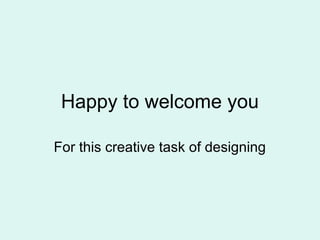
Design concepts
- 1. Happy to welcome you For this creative task of designing
- 2. What is a design ? • A plan or drawing produced to show the appearance and working of something before it is made. it is the plan intended for a purpose………our intend here is to design handloom textile products.
- 3. Elements of design • Lines • forms and shapes • colours • textures
- 4. lines • Gives direction, communication, the imaginary limits or outline of a product and form the shapes • Lines are 4 types, • 1. vertical lines • 2. horizontal lines • 3. diagonal lines • 4. curved lines
- 6. Forms and shapes • The outward form of something as produced by their outlines are perceived as its shape. • it may be natural forms • abstract forms • geometrical forms • conventional forms
- 8. colours • An objects property of producing different sensations in brain through the eyes of observers as a result of the way it reflects light. • Colour has its ……hue, value and tones.
- 10. textures • The feel , appearance , consistency, and surface nature of the designed products is termed as texture. • It is by using different fibres, counts, quality, density, and interlacements.
- 12. For designing you require • A theme • a storyboard • design concept • trend research • initial sketching • final sketches • repeats and patterning • product rendering
- 13. Theme • A subject on which a person speaks, writes, or thinks and • is expressed as an idea that is often repeated in a work of art.
- 15. Story board • It is the collection of pictures , images, photos, events, objects, words and phrases related with theme selected.
- 16. Design concepts • Is a word or phrase which symbolizes the inspired phenomenon, sense impression, empirical relationship and helps to communicate the design.
- 17. Trend research • It is the method of deciding consumer for the product by forecasting their colour preferences, textures, technology, etc: with reference to different occasions and lifestyles.
- 18. Initial sketching • Taking inspiration from design concepts and by utilising consumer preferences a design is drafted in paper to express the ideas hitherto in mind of designer.
- 19. Final sketching • By considering the loom and technology to be adopted for the production and principles of designs the draft design is modified to suit our requirement.
- 20. Principles of designs • Principles are concepts used to arrange the structural elements of design. when it is applied, it effects the expressive content or the message of the work. • It gives dynamism, life, and, aesthetics to designs.
- 21. Principles of designs • There are six principles generally followed by successful designers. • 1.balance • 2.proportion • 3.rhythm • 4.emphasis • 5.unity • 6.contrast.
- 23. balance • Balance is the concept of visual equilibrium and relates to our physical sense of balance. • Balancing are achieved in two ways: • 1. symmetrically- it is called as formal balancing by arranging elements equally around a central point or fulcrum. • 2. asymmetrically- it is also called as informal balance.it involves placement of objects in a way that will allow objects of varying visual weight to balance one another around a fulcrum point.
- 24. balancing
- 25. proportion • This refers to the relative size and scale of the various elements in a design. • The issue is the relationship between objects or parts of a whole. • Use appropriate scale in surface design.
- 26. proportion
- 27. rhythm • Rhythm can be described as timely movement through space, an easy connected path along with the eye follows a regular arrangement of motifs. • The presence of rhythm creates predictability and order in a composition. • Repetation, alternation, gradation is employed to motifs to achieve rhythm.
- 28. Rhythmic designs
- 29. emphasis • Emphasis refers as point of focus or interruption. • It marks the locations in a composition which most strongly draw the viewers attention. • Repetition, contrasting in colour or texture or shape, placement of motifs in strategic positions etc: brings emphasis.
- 30. emphasis
- 31. emphasis
- 32. unity • Unity is the underlying principle that summarizes all of the principles and elements of design. • It refers to coherence of the whole or harmony of all the parts. • Patterning, consistency in forms and colour, use of variety in elements etc: can achieve unity.
- 33. Good design
- 34. Repeats and patterning • The paper design is translated into the language of loom , and other production systems , technologies to adopt for converting into actual products by employing unit repeating techniques and movements in rhythm of machineries, tools and equipments .
- 35. Product rendering • This is the actual production process. the dream of designer becomes reality through dyeing, winding, warping, weaving, and finishing operations.
